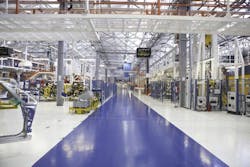If you want to manage your business, you need to visualize your processes
If you Want to Manage your Business, you Need to Visualize your Processes
Being able to see what’s happening inside a manufacturing process, whether it’s a single machine or an entire production line, has always been viewed as essential to improving operational efficiency and productivity. In the past, however, only a machine operator or the central control room had access to this kind of information.
The introduction of web technologies into the world of manufacturing has made it possible for higher levels of management to see what’s happening on the factory floor, often in real time. What they’re learning is changing how information is collected, what data is considered most valuable and how it’s displayed.
If you can visualize a manufacturing process, you can determine how different machines are functioning, identify faulty components or systems, and compare product quality or even the productivity of different work shifts. This provides vital information to plant and business managers in making operating and investment decisions.
Visualization Easier, Less Expensive
Thanks to technologies invented for the Internet, obtaining that information is now easier and less expensive than ever. Given the valuable insights to be gained, even the smallest manufacturer or those with few automated systems can gain bottom-line benefits from an investment in process visualization. Just as important, it can now be achieved without disrupting your production control systems or interfering with the work of the operators overseeing the equipment.
While operators and maintenance specialists with decades of experience working with plant equipment could often tell what’s wrong just by listening to the machines, the younger generation now joining the workforce doesn’t have that depth of experience. They must rely on data to tell them what’s not working properly and what to fix.
The most cost-efficient way to monitor and report information is to create an IT overlay to your existing control system, enabling machine information to be accessed in real time even from legacy equipment, often using sensors and a wireless network. This allows operators and managers to monitor the key performance indicators for systems critical to the manufacturing process.
This digital overlay can address the pain points that multiple personnel in a factory have in getting exactly the information they need to perform their functions:
• Operators/engineers who are too busy to manage their tasks manually and who lack a single platform to view all the information they need;
• Production managers who require dynamic machine efficiency for work order process management and need flexible order dispatch for quality and quantity control;
• Factory managers who lack statistical data for decision-making and data improvement tracking, and who could benefit from a dashboard that visualizes their process.
Since IT departments are typically responsible for this type of data collection and monitoring rather than operations personnel, it makes sense to create a visualization system built on IT rather than OT tools, such as IT-friendly I/O, a wireless infrastructure and open-source tools for creating dashboards.
Start Small and Grow
As companies move from manual reporting using clipboards to automated data gathering for display on dashboards, it’s important to start small,” says Mike Berryman, sector manager for smart manufacturing at Advantech Corporation’s IIoT Group. “Begin by monitoring a few systems, allowing you to build from there as you learn which data are the most important indicators of process health. Each new data point can tell you something useful for fine-tuning an aspect of your operations.
“When there’s a problem in production, a properly structured system to visualize your process can tell you what happened, why it happened, what’s being done to correct it and what needs to be done to make sure it won’t happen again,” says Berryman. “The goal is to detect patterns in the operation, determine where to time action when it matters most, take stock of important KPIs and identify where to improve your processes.”
Enabling both high-level views for managers and more detailed examinations for operators or maintenance technicians should be the goal of any process visualization project. “With a dashboard, you can put the whole facility on one page, and then drill down into the data as needed,” he says. “It isn’t about Big Data, it’s about smart data.”
All too often production-related equipment provides a view of only what is occurring at the single station or function level. With a digital dashboard, however, plant personnel can gain insight into overall status as well as identify bottlenecks and their causes.
Advantech’s integrated automation and cloud innovations, for example, can collect dynamic production process information and convert it into a status overview. With this overarching view, operators can better optimize production allocation, identify opportunities to improve overall efficiency, and trace the production process to assist in troubleshooting.
Smart Data, not Big Data
“Often you only need a few data points to determine whether a machine is running properly,” he says. “By putting in a simple wireless module to monitor current draw, for example, the company was able to identify when a machine was drawing too much or too little power. Technicians could then see whether they were dealing with a faulty component or an improperly tuned process.
“Most plant people know what’s the biggest bottleneck in the production process, but they don’t necessarily know which are the next two or three,” adds Berryman. “By collecting data you can tell where to focus your attention and begin to prioritize the investments you need to make to optimize your operations.
“Visualization has become a tool for managing a business, not necessarily a machine. It’s really about learning the best ways to deploy your resources: are all of them being applied to make manufacturing as productive and efficient as possible, so that you’re getting the maximum possible return on your investment?”

